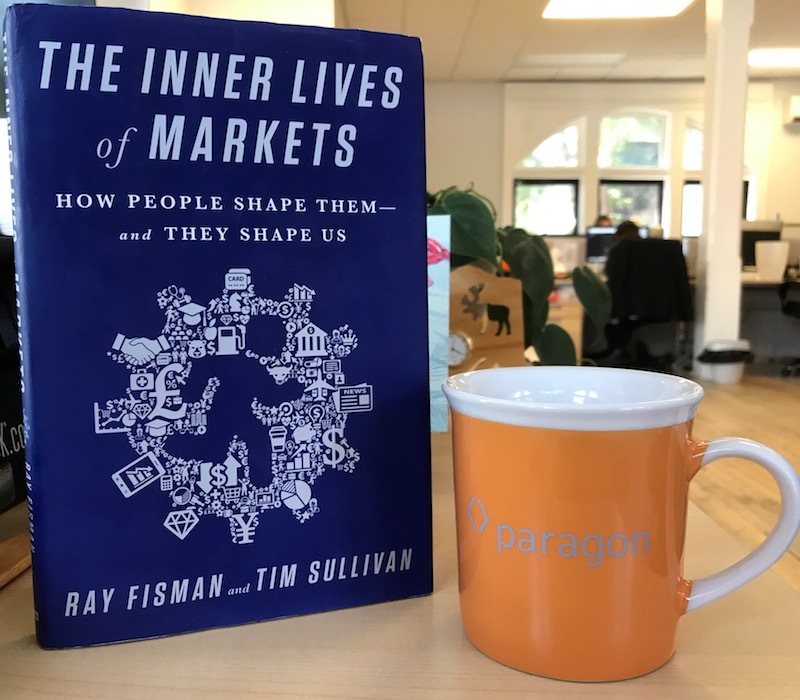Pages with P.J: The Inner Lives of Markets
The third Pages with P.J. column focuses on Tim Sullivan’s and Ray Fisman’s The Inner Lives of Markets, which examines the inner workings and evolution of market dynamics. From securities trading across the global capital markets to the online behemoths like eBay and Amazon that dominate online retail, markets influence our everyday lives whether we realize it or not. This book examines exactly how marketplaces function and how they have changed with the rapid pace of technology innovation.
To Infinity and Beyond…
The most important takeaway from this read is understanding where markets actually exist, and the answer, very simply, is everywhere. Credit cards, Facebook, and dating apps all comprise the ubiquitous, yet constantly expanding landscape of markets. Even prison has its own market, with inmates exchanging goods within the walls of their confines – a surprisingly useful example that Sullivan and Fisman revisit several times.
Markets require give and take, supply and demand. If everyone got what they wanted in the exact amount they wanted, markets wouldn’t be necessary or even exist. Interestingly, technology advancements have unfolded so quickly over the last decade, and have so significantly changed the way markets operate, that often, markets are now too complex and nebulous for the bulk of participants that comprise them. It’s akin to the Terms of Service of a new product. When purchasing a new iPhone or laptop, as the consumer we mindlessly just sign at the bottom before even looking at what it says. We’re not worried about the granular detail behind the product, just the end result that it provides us. With the complexity of today’s marketplaces, Sullivan and Fisman argue that “we need something simpler that shows us what we’re agreeing to.”
Still Buying. Still Selling.
One thing that hasn’t changed in market dynamics is the buyer-seller relationship. Sellers will always have an advantage – whether it’s selling used cars in a lot or new products online – they know things the buyers do not. Ironically, this is ultimately what can collapse a market. Sullivan and Fisman use the example of lemons versus cherries (average or used products versus premium, new products). Sellers of “lemons” will never offer a money-back guarantee since they’ll likely be dealing with more dissatisfied customers; whereas, sellers of brand new innovative products will almost always offer this feature.
This theory was a huge factor during the dawn of online retail when eBay and Amazon were initially gaining traction. Think about the huge leap of faith both buyers and sellers had to take during the very early days, before online credit and payment authorization was as thorough and secure as it is today. A buyer had to trust that the seller would ship the product, and the seller had to trust that they were going to receive payment once the transaction was fully processed. The bottom line is that as long as there is money to be had, there will be con-artists that are looking to make an extra buck, even facing increased policing and anti-fraud efforts by eBay and Amazon. The seller’s challenge is to always make sure their “signal” is credible.
Not All About Money
One of the book’s illustrations I found most interesting was the role of labels. Labels play a pivotal role in market functionality, especially on individuals. Take the job market for example. A Harvard degree says that someone works hard and may be great at math. But there are likely shortcomings of that job applicant that an employer will not know until they hire that individual. Similarly an individual with a gang tattoo will have a difficult time getting employed at most companies simply due to their visible ink.
One of the obvious, yet key points that is stressed throughout the book is that markets don’t always involve the exchange of money. A perfect example is online dating. There’s no monetary exchange, but instead an exchange of common interests and eventually trust. I should know, as this is how I met my fiancé.
Markets do so much for the greater good of society, such as with distribution and trading of food. But like many great ideas, they can also be detrimental and harmful if abused. This is a great read for anyone curious about the inner dynamics, psychology and evolution of marketplaces. There are a number of valuable things to keep in mind, especially with complexities of today’s markets, and sellers’ abilities to deceive buyers. One is the the old Groucho Marx line, which Sullivan and Fisman cite midway through the text, “If someone has something she really, really wants to sell you, there’s a good chance you shouldn’t be buying.”
Do you know of any great business books that you’d like me to review for a future Pages with PJ column? We welcome your suggestions.




Leave a comment:
You must be logged in to post a comment.